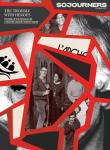IT WOULD HAVE been tough to be both a disciple of Jesus and a foodie. Don’t get me wrong, Jesus certainly valued food — his earthly ministry was filled with meals: The gospel of Matthew describes Jesus as one who “came eating and drinking” (11:19). As Robert J. Karris wrote in Eating Your Way Through Luke’s Gospel, Jesus was “either going to a meal, at a meal, or coming from a meal.” But what the Chosen One had in meal frequency, he lacked in meal diversity.
A “foodie” is someone who eats food as a hobby — a passion, even. The more exotic the better. If you pull up to your local boba shop, why settle for regular milk tea when you can order one infused with butterfly pea flower that turns it bright blue?
However, for Jesus’ meals, at least the ones recorded in scripture, the fish is served broiled (Luke 24:42), not creatively deconstructed. And if you’re rolling with Jesus, you better like eating bread.
Though his plate may have lacked the splendor of the centurions’ or high priests’ spreads, Jesus viewed the table as a radical place of inclusion. For many powerful religious leaders of the time, dining was yet another way to shun the outcasts. In contrast, Jesus intentionally invited those very same “unclean” people to dine with him, breaking bread (because of course it was bread) with tax collectors, sinners, and prostitutes.
In the past year, several films have articulated a hunger for the type of table Jesus championed. Flux Gourmet, Triangle of Sadness, and The Menu critique class inequality through stories revolving around fine dining. In each movie, wealthy people have rich flavors but a dearth of meaningful relationships. The exclusivity of the table seems more important than the actual food served on the plates. Jesus’ table, on the other hand, lacked variety but overflowed in inclusivity — a true palate cleanser to meals that symbolized selfish consumption.
Minor spoilers follow
FLUX GOURMET, directed by Peter Strickland, is the weirdest of the three films. While its plot doesn’t directly shish kebab the rich in the way Triangle of Sadness and The Menu do, it offers the most resonant (and viscerally disturbing) picture of what happens when we lose sight of what food and fellowship should be all about.
culture.flux_gourmet.image2_.jpg

The film tells the story of culinary artists Billy (Asa Butterfield) and Lamina (Ariane Labed), led by their teacher Elle (Fatma Mohamed). As residents of the Sonic Catering Institute, they spend their days attempting to extract various (and often disconcerting) sounds from food. Their workspace looks less like a kitchen and more like a cross between a church’s sound booth and a surgeon’s operating table; in this kitchen, speakers and headphones bump up against burners and blenders. The food in Flux Gourmet is not enjoyed; it’s explored and exploited — so alienated from its God-given purpose that it’s rendered unrecognizable.
If Flux Gourmet gives us a hint about how our relationship with food is fraught, Ruben Östlund’s Triangle of Sadness and Mark Mylod’s The Menu use food as a stand-in for wealth disparity. Triangle of Sadness is an unflinching satire that takes place on a cruise for the mega-rich. When the guests demand the entire staff get in the ocean for an impromptu swim, the cooking crew does so begrudgingly, knowing that the food they worked hard to prepare will spoil. The mayhem that ensues when the sun goes down is a moment of gross vindication. The crew serves the guests dinner, which they wolf down, being none the wiser. The food becomes even harder to digest when a storm hits the yacht, compounding food poisoning with seasickness. The guests all stumble back to their rooms, making no effort to clean up the mess that results — that task will fall to the people with less power, the crew. In Triangle of Sadness, the poisoned food is an extension of the abusive ways the rich have wielded their wealth, a nauseating reality.
Of the three films, The Menu gets into the meat and potatoes of how fine dining and “foodie” culture have warped relationships with food, even down to the very act of “eating.” The film follows couple Margot (Anya Taylor-Joy) and Tyler (Nicholas Hoult) who, alongside other rich guests, go to the island of Hawthorne to eat a multicourse meal prepared by celebrity chef Julian Slowik (Ralph Fiennes). Julian introduces the menu to his guests, curiously urging them to “not eat.” The guests look around in confusion before he clarifies: “taste, savor, relish ... consider every morsel that you place inside your mouth, be mindful, but do not eat. Our menu is too precious for that.”
culture.the_menu.image1.png

In one scene, the restaurant hostess introduces the “breadless bread plate.” On a platter, a few side sauces surround the centerpiece: a gaping void where bread should be. Julian argues that since bread has always been poor people’s food, the wealthy guests will not be eating bread — their meal must be commensurate with their social status. The scene is ludicrous and humorous, effectively showing the emptiness of wealth. Just because a meal is elaborate doesn’t mean it’s filling.
A welcome table
WHILE THESE FILMS showed us what not to do regarding food, Jesus shows us what to do. Juxtapose the breadless bread plate from The Menu with one of the most famous meal scenes in scripture, the Last Supper. In one of his final moments with his disciples, Jesus transforms the seemingly simple act of eating into a call to action. “Take, eat, drink, do this in remembrance of me,” Jesus says to his friends. Do not consume mindlessly. This table should be marked by sacrifice, not by exclusion.
There’s nothing inherently wrong with being a “foodie” or having a passion for quality food. (After all, Jesus certainly had high standards. He saved the best wine for last at the wedding of Cana.) The problem isn’t food, but how food is sometimes used to reinforce class structures. We can enjoy food without succumbing to destructive consumption habits. Consider a restaurant like Falafel Inc, located in the Georgetown neighborhood of Washington, D.C. An upscale neighborhood in one of the most expensive cities in the U.S. is a hard place to find a cheap meal. Falafel Inc stands out in that it offers high-quality food while keeping its prices affordable (the most expensive thing on its menu is $6!). The restaurant has partnered with the United Nations World Food Programme, the leading humanitarian food organization, to deliver aid to refugees around the globe. Clearly, there’s room to enjoy the best wine (or falafel) while promoting a greater good.
Flux Gourmet, Triangle of Sadness, and The Menu all offer portraits of our misaligned relationship with food. May watching these films whet our appetite for a renewed relationship with the table Jesus set more than 2,000 years ago — a place where the powerful are humbled and the lowly brought up.

Got something to say about what you're reading? We value your feedback!







